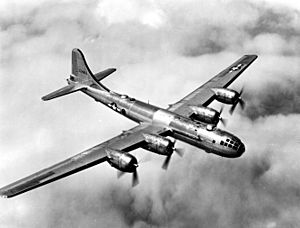Boeing B-29 Superfortress facts for kids
The Boeing B-29 Superfortress was a huge, four-engine bomber aircraft used by the U.S. Army Air Forces during World War II. It was named "Superfortress" because it was an improved version of the famous B-17 Flying Fortress.
The B-29, also known as the Boeing Model 345, was one of the largest planes used in World War II. It was also one of the most advanced bombers of its time. This powerful aircraft was used a lot by the U.S. to bomb Japan in the last months of World War II. B-29 planes also carried the atomic bombs that were dropped on Hiroshima and Nagasaki, which helped end the war. The B-29 stayed in service for many years after the war. About 3,900 of these planes were built before they were retired in the 1960s.
Images for kids
-
Boeing assembly line at Wichita, Kansas (1944)
-
The length of the 141-foot (43 m) wing span of a Boeing B-29 Superfortress based at Davis-Monthan Field is vividly illustrated here with the cloud-topped Santa Catalina Mountains as a contrasting background.
-
1000th B-29 delivery ceremony at Boeing Wichita plant in February 1945
-
Enola Gay, a Silverplate version of the Boeing B-29 Superfortress landing after delivering Little Boy over Hiroshima
-
Royal Air Force Washington B.1 of No. 90 Squadron RAF based at RAF Marham
-
Bell X-1 and its B-29 mother ship
See also
 In Spanish: Boeing B-29 Superfortress para niños
In Spanish: Boeing B-29 Superfortress para niños






















